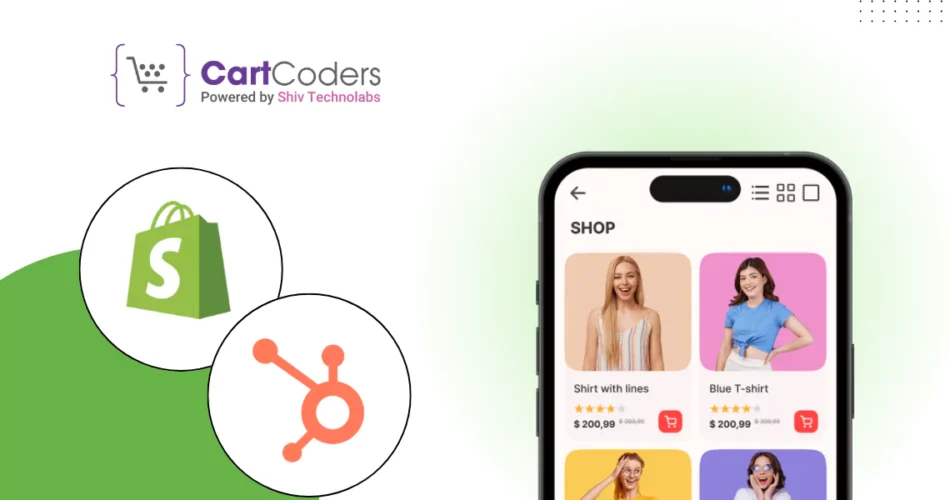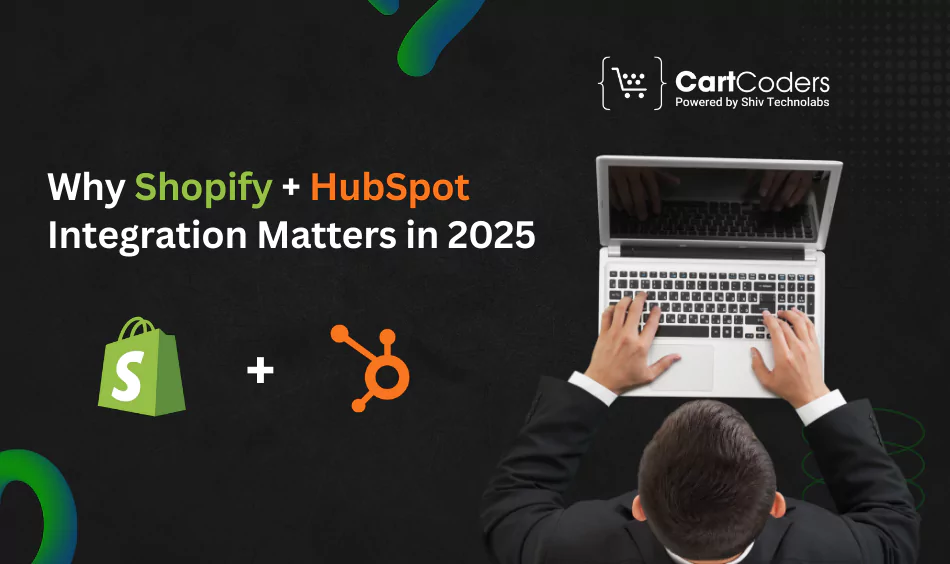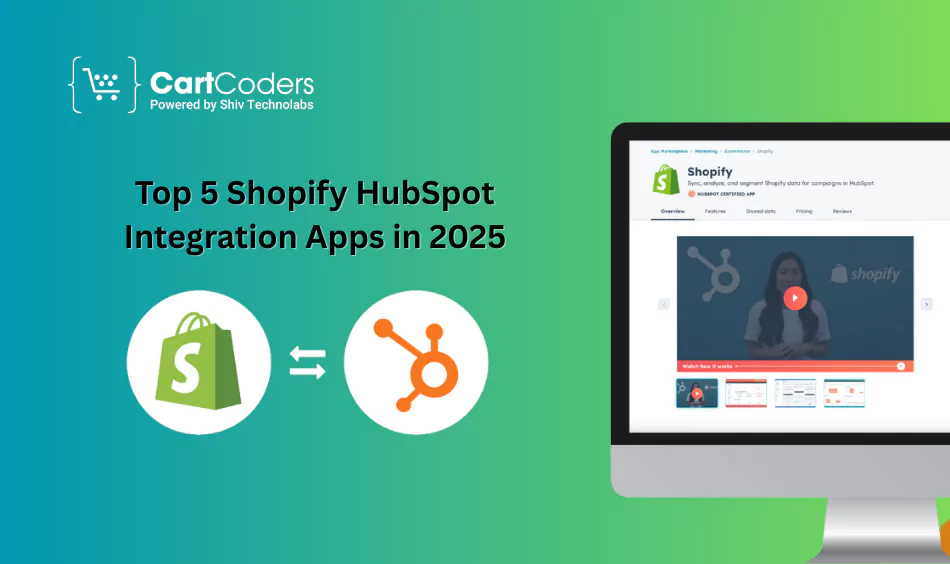Custom Engagement Solutions
Unlock tailored solutions with a free, no-obligation strategy session.
Expert Developers & Engineers on Demand
Scale Your Team with Skilled IT Professionals
Expert Guidance for Digital Transformation

Online shopping continues to grow every year. In 2025, people around the world are expected to spend about $6.3 trillion shopping online. Nearly 2.77 billion people now make purchases through websites and apps. This huge growth makes it really important to connect your Shopify store with HubSpot CRM tools.
Smart business owners use Shopify HubSpot integration apps. These apps help save time by automating tasks. They also help send the right messages to customers using information from your CRM system. Plus, they keep customer information updated across both platforms right away.
You can use these tools to bring back customers who left items in their cart. You can also send follow-up emails after people make a purchase. Having a good Shopify HubSpot integration in 2025 will help your business stay ahead of competitors.
This article explains the best tools available today. We’ll also talk about why these connections are so meaningful now. You’ll learn when it’s smart to hire experts to set everything up correctly. The following apps and approaches will accelerate the development of your business.

Automation, personalization, and good data flow between systems represent three things that modern businesses require to grow.
Shopify sends purchase data and customer behavior information straight to HubSpot. This creates a complete picture of each customer in your CRM system. You can then group customers based on their purchasing habits and shopping preferences. This smart grouping helps you send emails that actually lead to sales instead of annoying people with useless messages.
Special automated systems monitor activity in your Shopify store. When someone abandons their cart or makes a purchase, these systems automatically send the right emails at the right time. This saves you from manually checking and following up with customers all day long.
Basic apps work well for simple needs, but they have limits. More businesses now pay for professional Shopify integration services as they grow. These custom solutions give better control and can handle complex business rules that simple apps cannot manage.
Good Shopify CRM integration tools do more than just move data around. They automate workflows that otherwise take hours every week. They are also used to boost repeat sales by ensuring customers are entertained through personalized messages.
Three different methods exist to connect Shopify with HubSpot. Each option works best for different types of businesses and technical skills.
HubSpot provides a direct connection app through the Shopify App Store. This app moves customer information, product details, order data, and abandoned cart information into HubSpot’s system. It also brings in old data from before you installed the app. The setup process is quick and costs nothing to install. However, you cannot create custom triggers or rules beyond what HubSpot allows by default.
Apps like Automate io, Zapier, Make and PieSync give you more options for automation. These tools let you create workflows with specific conditions and advanced triggers. They have easy-to-use visual builders and can sync more types of data. Think of them as “Shopify integration services lite” because they offer more power than basic connections but still have some limits when your needs get really complex.
Large businesses using HubSpot Enterprise or Shopify Plus often need custom solutions. Companies that work with ERP systems or have complex CRM needs also benefit from custom builds. CartCoder, the best professional Shopify integration company, builds connections at the API level. They build enterprise workflows and tools designed specifically for your business needs.

The five apps have been chosen because of their simplicity to operate, data syncing capabilities, excellent automation features, and reliability.
Many Shopify store owners need more than basic data sharing between their shop and HubSpot. Katana fills this need perfectly in 2025. This tool connects your online store with HubSpot’s customer management system. It also handles your stock levels and production tasks simultaneously. Store managers can send order details to HubSpot and keep all product data in sync.
The app tracks your sales records next to your manufacturing work and inventory counts. Businesses that sell directly to customers or make their own products find Katana very helpful. It ensures your HubSpot sales information aligns with your actual inventory and shipping capabilities from Shopify.
Key Features:
Zapier stays popular in 2025 as a flexible way to link Shopify with HubSpot. This tool is not your typical sync app that works right out of the box. Instead, Zapier lets shop owners automate boring tasks between both platforms without writing any code. You can set it up to automatically move new Shopify customers into HubSpot as contacts. It can also create HubSpot deals every time someone places a new order in your Shopify store. This app is well-suited for companies seeking simple automation without the need for heavy-duty data syncing tools.
Key Features:
Shopify merchants seeking to capture more leads find this app particularly useful. The HubSpot Forms Integration app makes lead collection much easier than using messy embed codes. You can add HubSpot forms right into your Shopify store pages without any hassle. The app lets you change form fields, colors, and how forms behave on both computers and phones. All lead information goes straight into HubSpot CRM without any extra steps. In 2025, businesses use this app to grow their email lists faster, sort leads better, and build detailed customer profiles in HubSpot. The setup process stays simple and quick.
Key Features:
MESA has grown stronger in 2025 as an automation tool, especially for merchants who prefer to work within the Shopify environment rather than using external tools. MESA is specifically designed to work only with Shopify, and therefore, it is not similar to Zapier.
It is packaged with out-of-the-box recipes that integrate Shopify and HubSpot in a few clicks. You may sync the customer data to HubSpot or configure automatic follow-ups after the purchase. The app also handles abandoned cart emails without any coding work needed. Store owners seeking seamless HubSpot integrations within Shopify prefer MESA as their primary solution.
Key Features:
SyncSpider serves as a powerful integration platform, providing highly customizable connections between Shopify and HubSpot in 2025. This tool goes beyond simple automation apps. SyncSpider targets businesses that handle complicated systems like multiple sales channels, ERP software, and customer management tools.
It gives you detailed control over how information moves between Shopify and HubSpot. You can map custom fields, sync huge amounts of data, and manage several stores at once. Merchants who grow beyond basic sync apps find that SyncSpider offers the flexibility and growth potential to keep operations and customer data aligned across both platforms.
Key Features:
This table comparison will assist you in making the correct decision about the choice of tool, depending on cost, ease of use, feature set, and the size of the business.
| App | Best For | Why Choose It | App | Best For |
| Katana Cloud Inventory | DTC brands and manufacturers | Combines HubSpot CRM data with Shopify orders, stock, and production tracking. | Katana Cloud Inventory | DTC brands and manufacturers |
| Zapier: Workflow Automation | Small to mid-size stores needing flexibility | Build quick, no-code workflows between Shopify and HubSpot without heavy setup. | Zapier: Workflow Automation | Small to mid-size stores needing flexibility |
| HubSpot Forms Integration | Lead generation & email list growth | Simplest way to capture leads directly into HubSpot via embedded forms. | HubSpot Forms Integration | Lead generation & email list growth |
| MESA: Workflow Automation | Shopify-first businesses wanting automation | Prebuilt workflows designed specifically for Shopify ↔ HubSpot sync. | MESA: Workflow Automation | Shopify-first businesses wanting automation |
| SyncSpider | Integration | Enterprise and complex multi-channel setups | SyncSpider | Integration |
Ready-made apps solve many common problems. However, when you need exact specifications, large-scale handling, and deep customization, a professional Shopify integration company like CartCoders becomes your strategic advantage.
Complex business logic, custom calculations, or connections with ERP solutions require more than what simple apps can provide. Standard website apps cannot handle these advanced requirements.
Large-scale operations need enterprise-level logic and data handling systems. Custom integration prevents workflow limitations and ensures your systems run smoothly.
Advanced customer lifecycle management requires seamless connections between POS systems, ERP platforms, and logistics tools. Template-based solutions cannot handle these complex integrations. CartCoders provides both strategy planning and technical execution that aligns all your tools with your growth goals.
Do you want CRM automation that fits exactly how your business grows? Are you ready to stop using multiple disconnected tools and start building real business connections?
CartCoders can help:
You now know about the best Shopify HubSpot integration apps available in 2025. The official HubSpot app, Automate io, Zapier, Make, and PieSync (or its updated alternatives) can all be used by a business organization in different ways. Some are simple, and some offer advanced features. Some focus on simplicity, while others provide advanced features. The right integration increases customer lifetime value by creating personalized experiences and letting your team focus on business growth.
However, when your needs include ERP systems, complex customer journeys, or enterprise-scale operations, basic tools reach their limits. This is when CartCoders becomes essential for your business. We offer HubSpot eCommerce integration services that grow smoothly with your business and improve ROI both now and in future years.
Do you want to improve your CRM system, make your data work better, and keep customers coming back? Let’s build an integration that works perfectly from the first day.
The optimal tool primarily depends on your technical capability and needs. Your best bet is the official HubSpot app to sync reliably and freely. Zapier works well for users who want flexibility without coding knowledge. Automate IO and create suitable stores that require conditional workflows. For enterprise-grade two-way sync, PieSync (or a modern equivalent) provides the best results.
Yes, the HubSpot-Shopify integration app is free to install. It requires a HubSpot account to use and maybe some automation functionality within HubSpot will require paid plans but the core integration app is totally free..
Yes, but only through tools that support two-way sync and custom property mapping. PieSync (or its 2025 replacement) handles tags, segments, and list synchronization instantly. Other apps might only transfer orders or basic contact information.
Native integration, like the HubSpot app provides fast, reliable setup designed specifically for Shopify events. Zapier adds flexible workflows with conditional logic and thousands of ready-made templates, but it may need regular maintenance and has usage limits.
Yes, absolutely. A Shopify integration company like CartCoders can create customized automation flows, custom CRM logic, and integrations with ERP or POS systems. This makes your HubSpot and Shopify connection not just functional but strategically valuable for your business.
Projects delivered in 15+ industries.
95% retention rate, building lasting partnerships.
Serving clients across 25+ countries.
60+ pros | 10+ years of experience.